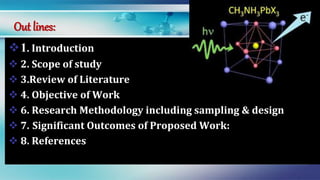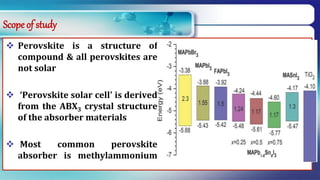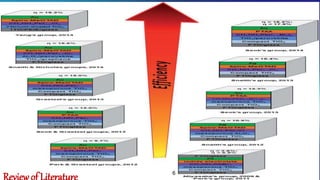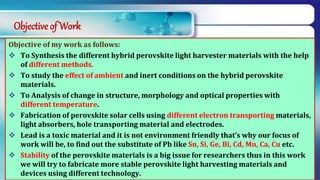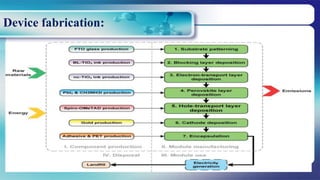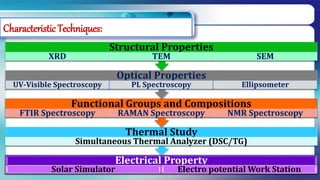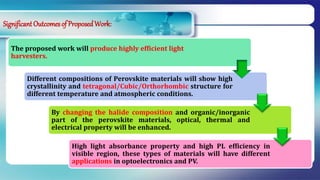Research proposal on organic-inorganic halide perovskite light harvesting materials
- 1. LOGO STUDY OF ORGANIC – INORGANIC HALIDE PEROVSKITE LIGHT HARVESTING MATERIALS & THEIR APPLICATIONS By- RAJAN KUMAR SINGH Supervisor- Prof. RANVEER KUMAR Department of Physics Dr. H. S. Gour Central University, Sagar , 470003, M.P. India RESEARCH PROPOSAL ON (rajanphysicssgo@gmail.com)
- 2. Out lines: 1. Introduction 2. Scope of study 3.Review of Literature 4. Objective of Work 6. Research Methodology including sampling & design 7. Significant Outcomes of Proposed Work: 8. References
- 4. Scope of study Perovskite is a structure of compound & all perovskites are not solar ‘Perovskite solar cell' is derived from the ABX3 crystal structure of the absorber materials Most common perovskite absorber is methylammonium lead trihalide CH3NH3PbX3 (optical band gap between 1.5 and 2.3 eV)
- 6. 6
- 7. Objective of Work Objective of my work as follows: To Synthesis the different hybrid perovskite light harvester materials with the help of different methods. To study the effect of ambient and inert conditions on the hybrid perovskite materials. To Analysis of change in structure, morphology and optical properties with different temperature. Fabrication of perovskite solar cells using different electron transporting materials, light absorbers, hole transporting material and electrodes. Lead is a toxic material and it is not environment friendly that’s why our focus of work will be, to find out the substitute of Pb like Sn, Si, Ge, Bi, Cd, Mn, Ca, Cu etc. Stability of the perovskite materials is a big issue for researchers thus in this work we will try to fabricate more stable perovskite light harvesting materials and devices using different technology.
- 10. Electrical Property Solar Simulator Electro potential Work Station Thermal Study Simultaneous Thermal Analyzer (DSC/TG) Functional Groups and Compositions FTIR Spectroscopy RAMAN Spectroscopy NMR Spectroscopy Optical Properties UV-Visible Spectroscopy PL Spectroscopy Ellipsometer Structural Properties XRD TEM SEM Characteristic Techniques:
- 11. Yearly Research plan 1st Year • We set up laboratory. We will study literature survey and find out research objectives. In the same year we order for chemicals and glass wares. The purchasing of instrument will be done. 2nd year • In this year we will synthesize light harvester material with different Organometalic halides and mixed halide. Such as CH3NH3PbCl3, CH3NH3PbI3-xClx, etc. with wet chemical method. We will synthesize both powder as well liquid hybrid perovskite precursors. 3rd Year • We will study the morphological, structural, optical, thermal and electrical properties of light harvester and PV device with the help of AFM, SEM, XRD, TEM, FTIR, Raman Spectroscopy, NMR, UV-Visible spectroscopy, ellipsometer, solar simulator, DSC and DTA. We will also testing the stability of fabricated device with different conditions. 4th Year • All characterized data will be analyzed in 4th year. We also investigate the effect of temperature, humidity, UV light and water on the perovskite solar cell device. We will co-relate different types of organic-inorganic halide perovskite material and find out which will be more suitable than others. In this year we will also write manually script/papers for publication.
- 12. SignificantOutcomesof ProposedWork: Different compositions of Perovskite materials will show high crystallinity and tetragonal/Cubic/Orthorhombic structure for different temperature and atmospheric conditions. The proposed work will produce highly efficient light harvesters. By changing the halide composition and organic/inorganic part of the perovskite materials, optical, thermal and electrical property will be enhanced. High light absorbance property and high PL efficiency in visible region, these types of materials will have different applications in optoelectronics and PV.
- 13. References: •V. S. Reddy, S. C. Kaushik, K. R. Ranjan and S. K. Tyagi, Renewable Sustainable Energy Rev., 2013, 27, 258–273. •Wei Wang, Moses O. Tade and Zongping Shao, RSC chm. Soc. Rev. 2015 •C.K. Moller, Nature 182 (1958) 1436. •D. Weber, Inst. Anorg. Chem. Univ. Stutt. 33b (1978) 1443-1445. •Research Cell Efficiency Records, NREL (2015). http://www.nrel.gov/ncpv/images/efficiency chart.jpg •M. Graetzel, et al. Nature 488 (2012) 304. •Aharon S. and Etgor L.; Nano Let, 2016, 16, 3230-3235. •Huang L.; Hu Z.; Solar Energy Materials and Solar Cells, 2016, 149, 1-8.
- 14. LOGO THANK YOU


